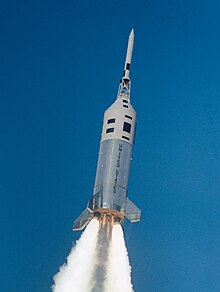
Back Литъл Джо (ракета) Bulgarian Little Joe II Czech Little Joe II Spanish Little Joe II Finnish Little Joe II Galician Little Joe II Hungarian Little Joe II Italian リトル・ジョーII Japanese Little Joe II Portuguese
This article needs additional citations for verification. (January 2013) |
 Launch of Apollo A-002 escape system test on the third Little Joe II | |
| Function | Apollo launch escape system testing |
|---|---|
| Manufacturer | Convair Division of General Dynamics |
| Country of origin | United States |
| Size | |
| Height | 1,032 inches (26.2 m) with payload |
| Diameter | 154 inches (3.9 m) |
| Width | 341 inches (8.7 m) at fins |
| Stages | 1 |
| Launch history | |
| Status | Retired |
| Launch sites | Launch complex 36, White Sands Missile Range, New Mexico |
| Total launches | 5 |
| Success(es) | 4 |
| Partial failure(s) | 1 |
| First flight | 28 August 1963 |
| Last flight | 20 January 1966 |
| Boosters | |
| No. boosters | 6[N 1] |
| Powered by | 1 Thiokol 1.5KS35000 Recruit |
| Maximum thrust | 38,000 pounds-force (170 kN) |
| Total thrust | 228,000 pounds-force (1,010 kN)[N 1] |
| Burn time | ~1.53 s |
| Propellant | Solid |
| First stage | |
| Powered by | 1 Aerojet Algol 1-D sustainer[N 2] |
| Maximum thrust | 105,100 pounds-force (468 kN)[N 2] |
| Burn time | ~40 s |
| Propellant | Solid |
Little Joe II was an American rocket used from 1963 to 1966 for five uncrewed tests of the Apollo spacecraft launch escape system (LES), and to verify the performance of the command module parachute recovery system in abort mode. It was named after a similar rocket designed for the same function in Project Mercury. Launched from White Sands Missile Range in New Mexico, it was the smallest of four launch rockets used in the Apollo program.
Cite error: There are <ref group=N> tags on this page, but the references will not show without a {{reflist|group=N}} template (see the help page).